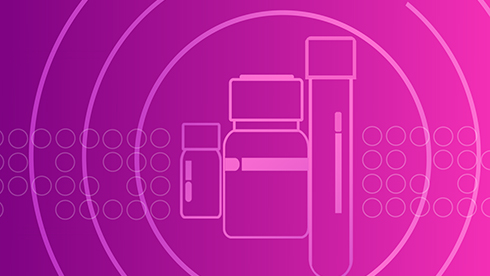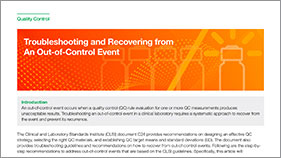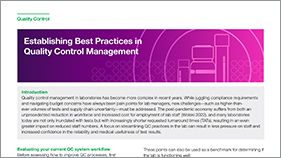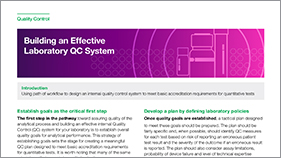Optimizing QC Procedures
Introduction Quality control management is an essential task in the clinical laboratory, and it is guided by requirements and standards like the Clinical Laboratory Improvement Amendments (CLIA) in the U.S. and the International Organization for Standardization (ISO) 15189:2022. Additional sources of information can be obtained from accreditation bodies such as the College of American Pathologists or The Joint Commission. While many labs have well-established QC processes in place, they need to be reviewed periodically since new or updated guidance for improved QC practices continues to be developed and published. This article highlights QC practices that are likely to benefit from updates, including establishing QC targets and ranges, the need for peer reporting, and managing risk in case of erroneous results.
QC practices that could benefit from updates and optimization
1. Establishing QC Targets and Range One of the most crucial tasks in quality control is establishing QC targets and ranges, or standard deviations (SD), for new lots of controls. The common practice of measuring 20 results over 20 days was studied almost a decade ago and the guidance for number of points was revised. A updated practice, based on statistical analysis, is recommended in document C24 from the Clinical and Laboratory Standards Institute (CLSI), Statistical Quality Control for Quantitative Measurement Procedures. Evaluation of new lots can performed faster with fewer QC materials to provide initial QC targets. Calculating the new target mean can be done by measuring ten QC results on separate days, then using the existing long-term CV for the range. By updating this practice, laboratories can benefit from significant time and cost savings while demonstrating following practices recommended by a standards development organization.
2. QC Frequency a nd Testing Volume The frequency of running QC is another important practice that has been defined by commonly accepted minimum requirements. Testing two levels of QC once each day has been the fixed minimum for many laboratories with a few exceptions, such as blood gas and coagulation QC, which are often run more frequently (every eight hours). With modern instruments running in continuous testing mode, the QC schedule (or when to test QC) is now as important as how many QC processes are tested and what QC rules are applied. To limit reporting of erroneous patient results, it is not the time between QC events that is most important, but the number of patient samples run between these QC events. In case of QC failure and the expected evaluation of tests performed since the last passing QC, labs with high volumes may want to limit the number of patients between QCs to a number that is more manageable.
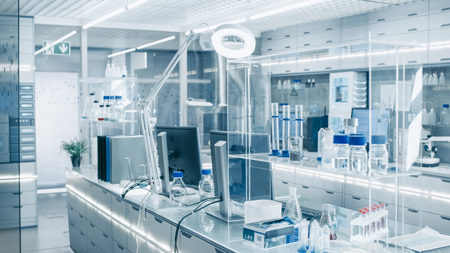
3. QC Frequency and Critical Control Points Another essential consideration in enhancing QC practices is understanding critical control points. It is important to end a testing run that occurs before a critical event with QC. These critical events are tasks that might adversely impact the measurement procedure, such as replacing reagents, performing maintenance, or calibrating instruments. The QC process can confirm that the instrument was still performing within normal specifications throughout the testing run that occurred before the critical event. After execution of the critical event, a lab should start the new run with another QC procedure to ensure the critical event did not negatively impact instrument performance. QC procedures should also be executed at the end of the day to confirm whether the patient samples tested throughout the previous day were produced while the instrument was still performing within acceptable specifications.
4. Peer Reporting Another important QC practice is peer reporting. Peer reporting involves the sharing of QC data among labs to identify potential issues, trends, or challenges in the testing process. This can help detect and identify any bias in test methods in addition to supplementing proficiency testing (PT) / external quality assessment (EQA). Peer reporting allows the lab to benchmark their QC results against others and have greater confidence in QC test results. Some accreditation bodies now require peer reporting and it has become an essential practice in managing risk and enhancing QC processes.
5. Managing Risk in Case of Erroneous Results The final critical QC practice is managing risk in case of erroneous results due to a failure of the assay. It is essential to have a process in place to identify, evaluate, and mitigate erroneous results. The process should involve a root cause analysis to identify the underlying cause of the error, and appropriate corrective actions to be taken. Informing the ordering provider of the erroneous result is necessary to manage the risk of patient harm until the sample can be retested.

Conclusion In conclusion, QC management is a crucial task in the clinical laboratory that needs to be reviewed periodically for potential improvement or enhancement. The latest trends and guidance in QC practices can help laboratories optimize and improve their QC processes, which can provide them with useful insights and benefits.

